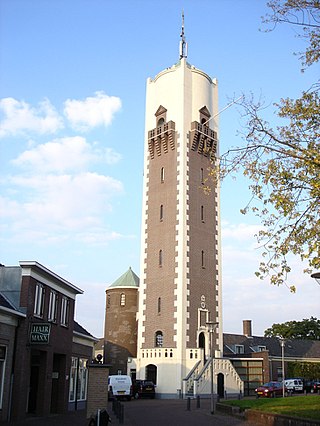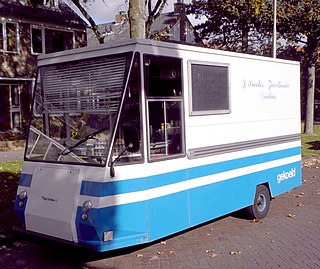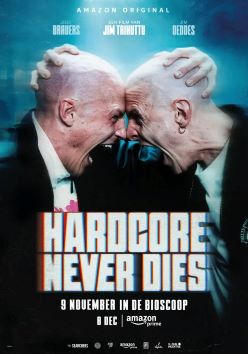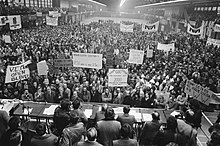
Barendrecht is a town and municipality in the west of the Netherlands, near Rotterdam, South Holland. The municipality had a population of 48,643 in 2021, and covers an area of 21.73 km2 (8.39 sq mi) of which 1.98 km2 (0.76 sq mi) is water.

de Volkskrant is a Dutch daily morning newspaper. Founded in 1919, it has a nationwide circulation of about 250,000.
Bouncy techno is a hardcore dance music rave style that developed in the early 1990s from Scotland and Northern England. Described as an accessible gabber-like form, it was popularised by Scottish DJ and music producer Scott Brown under numerous aliases.

Robert Adriaan van der Horst is a Dutch former field hockey player who played as a defender and currently the assistant coach of the first men's team of Oranje-Rood.

Foeke Booy is a Dutch football manager, executive, and former player. He serves as the technical manager of Cambuur.

Bokito was a male western gorilla born in captivity that lived most of his life in Diergaarde Blijdorp zoo in Rotterdam, the Netherlands. He became the subject of considerable media coverage after breaking out of his enclosure on 18 May 2007, abducting a female visitor and severely injuring her.
Rotterdam Records was a Dutch record label founded by Paul Elstak in 1992. It released hardcore and gabber music. It stopped in 2012 and restarted again in 2018 with MP3 releases.

Olli is a Dutch children's book character and a stuffed toy. The character Olli was created in 2004 by Dutch designer and film director Hein Mevissen along with writer Diederiekje Bok as a character for a bottled mineral water. Olli was one of the many characters used on the packages and posters of the bottled water brand and John's Phone. Olli was launched at a party of MTV In Rotterdam in 2004. In 2013, Olli was again part of a campaign, this time to save the Rotterdam Zoo Diergaarde Blijdorp. Olli is part of the Ollimania family which is the company that created and owns all characters. After the launch, Olli became the symbol of Rotterdam and a mascot for professional football club Feyenoord. On 10 September 2015, Ollimania and its creators Hein Mevissen and Diederiekje Bok donated a huge Olli statue to the Sophia children's hospital in Rotterdam.

Hotel New York is a hotel in Rotterdam, the Netherlands, based in the former office building of the Holland America Line. It was used as temporary accommodation for European emigres in the late 19th and early 20th centuries: "Often, package deals were available which would combine a train ticket, hotel accommodation and passage over the oceans."

Spijkstaal is a Dutch car company from Spijkenisse, Netherlands. It specializes in electric cars, especially trucks for industrial usage. Its electric carts operate in Amsterdam Airport Schiphol, flower auctions including the Royal FloraHolland, and military airfields. Among the general public, Spijkstaal is mostly known for being the manufacturer of mobile grocery stores.
Gabber is a style of electronic dance music and a subgenre of hardcore techno, as well as the surrounding subculture. The music is more commonly referred to as hardcore, and is characterised by fast beats, distorted and heavy kickdrums, with dark themes and samples. This style was developed in Rotterdam and Amsterdam in the 1990s by producers like Marc Acardipane, Paul Elstak, DJ Rob, and The Prophet, forming record labels such as Rotterdam Records, Mokum Records, Pengo Records and Industrial Strength Records.

Pieter Abramsen was a Dutch sculptor, and visiting professor at the Delft University of Technology, known for his work in which abstraction and realism are joined.

Denzel Justus Morris Dumfries is a Dutch professional footballer who plays as a right-back or right wing-back for Serie A club Inter Milan and the Netherlands national team.

Severiano Boris "Seve" van Ass is a Dutch former field hockey player who played as a midfielder or forward for the Dutch national team.
Jack B. van den Berg is a Dutch football manager and a former player. While coaching ASWH, he won the 2005 national amateur championship and the 2006 Rinus Michels Award for managers in nonprofessional leagues. During a long stint at BVV Barendrecht Van den Berg became a full-time coach. In 2015–2016 he coached the first squads of two small town rivals, promoting both ASWH to the Saturday Derde Divisie and IFC to the Sunday Hoofdklasse. From February until October 2018 he coached VV Katwijk, winning a Tweede Divisie championship.

Kevin Felida is a professional footballer who plays as a defensive midfielder for Eredivisie club RKC Waalwijk. Born in the Netherlands, he represents the Curaçao national team.

Barbara Catharina Kathmann is a Dutch politician, serving as a member of the House of Representatives since 2021. She is a member of the Labour Party (PvdA). Before being elected to the House, she served as a municipal councilor and alderwoman in her hometown Rotterdam. Kathmann has also worked in media and at two nonprofit organizations.

The Regio Songfestival is a Dutch song competition between regional public broadcasters. Held in its current form since 2023, the format of the competition is loosely based on the Eurovision Song Contest and was first used in 1995 under its original title Het Nederlandse Songfestival. Every edition features thirteen original songs that are performed in a live broadcast, each representing a region of the Netherlands. From the competing entries, a winner is determined through a combination of televoting and votes cast by regional juries.

Hardcore Never Dies is a 2023 Dutch crime drama film directed by Jim Taihuttu. The film won the Golden Film award after having sold 100,000 tickets. The film takes place during the gabber music scene in Rotterdam, Netherlands in the 1990s.

The Dutch Song Contest 1995 was a one-off song competition between regional public broadcasters in the Netherlands. The contest was held on 25 May 1995 at the Muziekcentrum Vredenburg in Utrecht and was hosted by Karin Bloemen. It served as a substitute for the Nationaal Songfestival, the Dutch annual selection show for the Eurovision Song Contest, which was not held that year due to the Netherlands' relegation from the Eurovision Song Contest following an insufficient result in the 1994 edition.





















